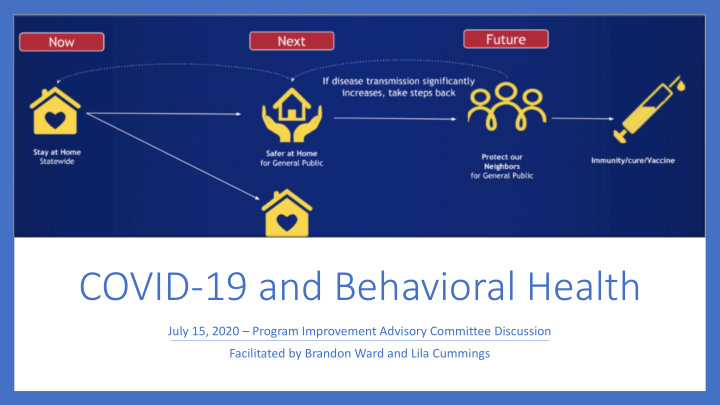



COVID-19 and Behavioral Health July 15, 2020 – Program Improvement Advisory Committee Discussion Facilitated by Brandon Ward and Lila Cummings
Discussion Topic While the physical health care community has seen a significant decrease in utilization during the COVID-19 pandemic, the behavioral health community has seen consistent utilization. This trend, particularly the uptick in substance use disorder treatment, indicates a significant traumatic undercurrent of COVID-19. • How has COVID-19 impacted behavioral health in communities across the state? • How can the state and communities prepare and evolve to meet the behavioral health needs as the pandemic unfolds?
Discussion Questions • How has behavioral health care changed in delivery, utilization and severity? How might it continue to change? • Are there particular populations and services that need additional attention? • What data should/could HCPF and the RAEs track moving forward? • What additional flexibilities do providers need?
Behavioral Health in a Pandemic – Different from Other Emergencies? From: https://www.samhsa.gov/dtac/recovering- disasters/phases-disaster
Behavioral Health Trends • Still waiting on most claims data • Broad trends point to undercurrent • Increase in alcohol sales (55% nationwide uptick in March) • Increase in crisis hotline calls • Majority of people say COVID has negatively impacted their mental health (Colorado Health Foundation) • Anecdotal evidence and provider group analyses can provide some initial insight
Behavioral Health Trends – Preliminary Impressions Topic RAE (3 and 5) Provider – CMHCs Provider – Hospital • • • Delivery At least 50% of services via Outpatient (OP) services moved to OP services moved to telehealth telehealth, mostly phone telehealth • Crisis, detox, residential, hospital alternative, ACUs, all in person • • • Utilization Decrease in services relative to Decrease in OP services Initial decrease in ED • • RVUs/payment due to large Large decrease in drop-in, crisis, OP services initially decrease in drop-in services prevention, IOP, and groups decreased, but returning • Decrease for school age youth • • Severity Increased calls for crisis, but less visits to Increased severity in ED on site crisis services • Decrease in new OP admissions • • • Financial Relatively steady in terms of RAE dependent RAE dependent • • payments network wide Overall revenue reduction Overall revenue reductions • • • Other Penetration rates down, mainly Decrease in no-shows, especially for high Decrease in no-shows related to increased members intensity services
Reminder: Discussion Questions • How has behavioral health care changed in delivery, utilization and severity? How might it continue to change? • Are there particular populations and services that need additional attention? • Demographics • Health conditions • Service modalities • What data should/could HCPF and the RAEs track moving forward? • What additional flexibilities do providers need?
Recommend
More recommend